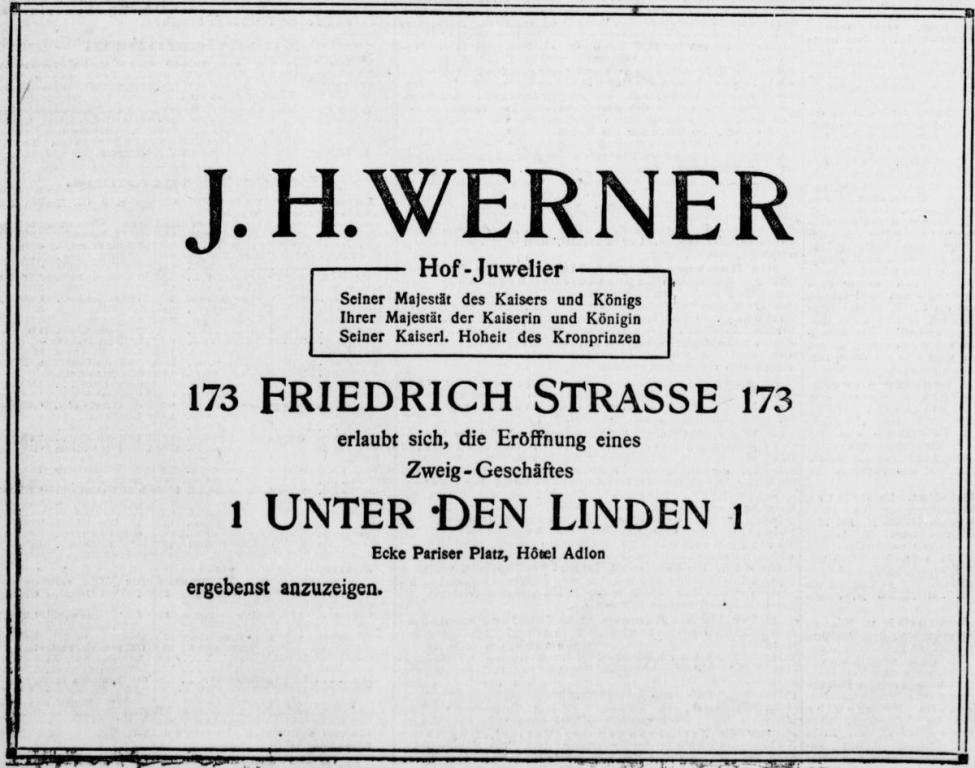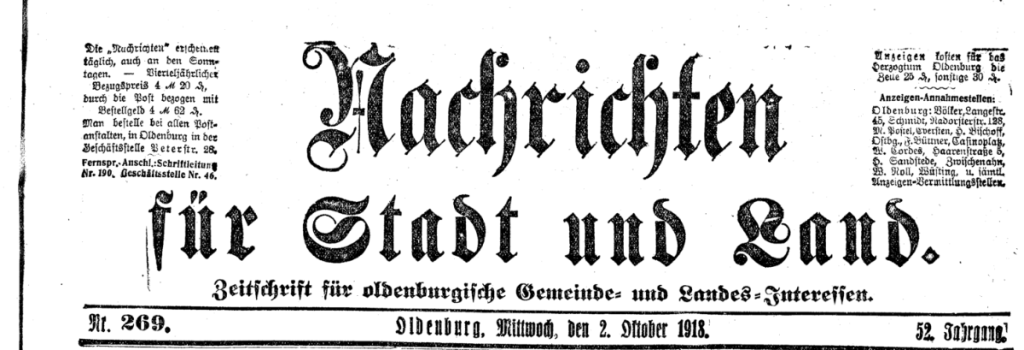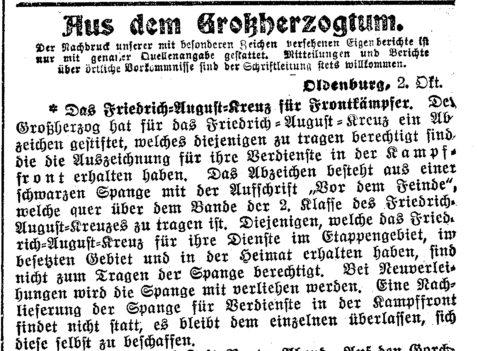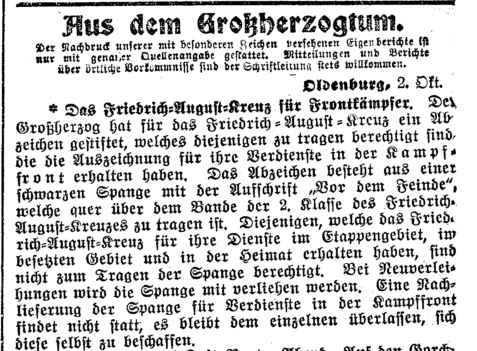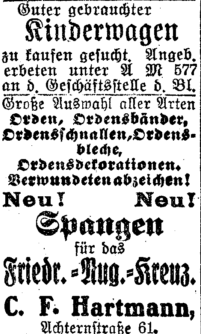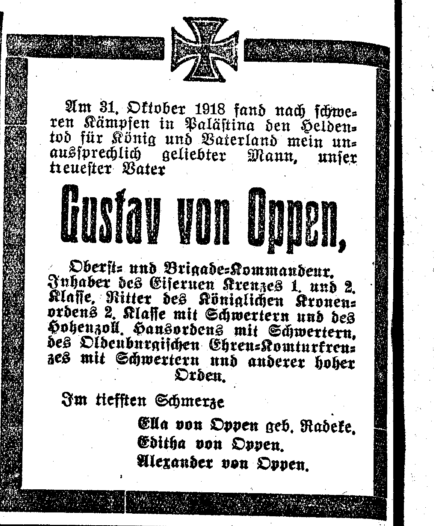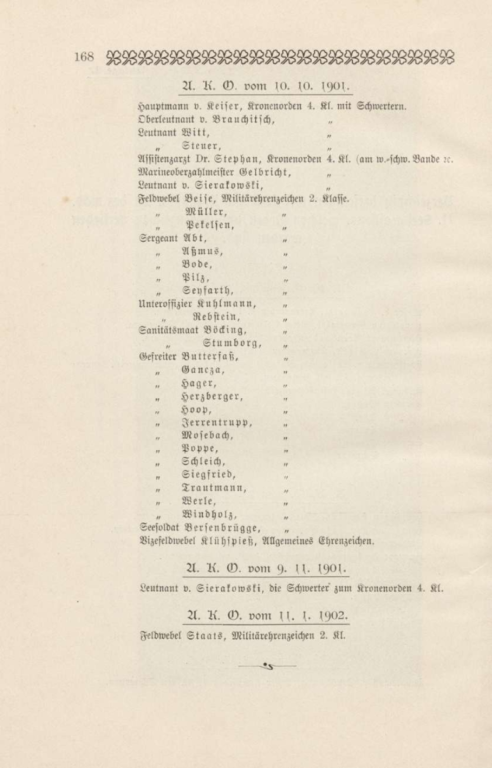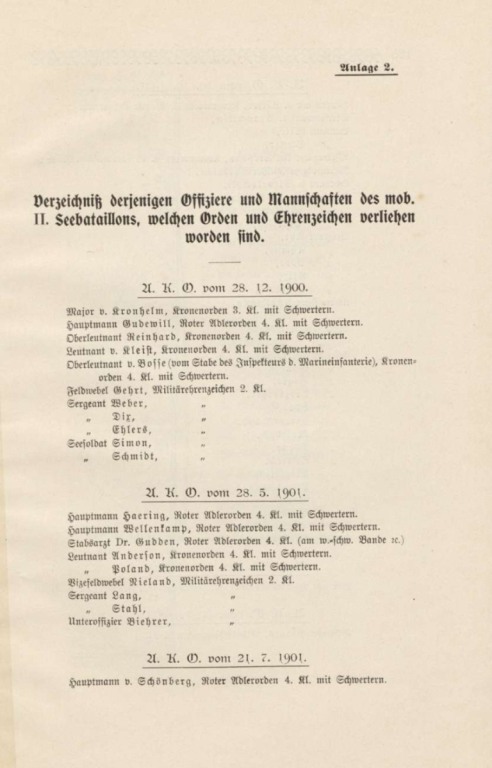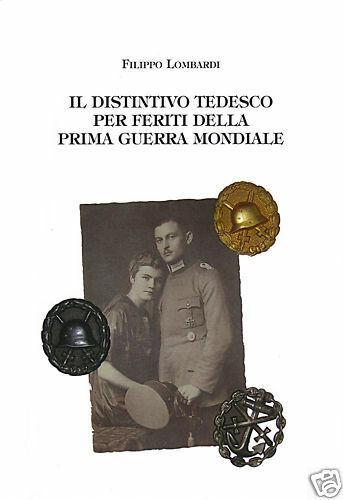
chuck
Past Contributor-
Posts
248 -
Joined
-
Last visited
-
Days Won
1
Content Type
Profiles
Forums
Blogs
Gallery
Events
Store
Everything posted by chuck
-
Vor dem Feinde Newspaper
chuck replied to chuck's topic in Deutsche Kaiserreich: Man spricht Denglish
I wanted to take a moment and clarify the source of this discussion. The announcement for the "Vor dem Feinde" bar was published in the Oldenburg newspaper Nachrichten fur Stadt und Land on 02 October 1918 Nr 269 (see attached front page clip). I have gone back and reviewed the newspaper from the institution date of 20 SEP18 until the date of the announcement 02Oct18 and could not find any additional announcements or mentions of the "Vor dem Feinde" bar. Typically, there was at least one announcement Titled from the Grand Duke" "Aus dem Grossherzogtum" published each day listing various promotions, awards, and other items presented or about the officers and men of Oldenburg military. The Nachrichenten fur Stadt und Land according to the German Wiki was first published fin 1867 and was a major regional paper around the time of the 1st World War with a circulation of about 30,000 copies. Given these facts i would deduce that announcement served as general implementation instructions for the citizens of Oldenburg on the newly established Vor dem Feinde bar for the already existing Friedrich August Cross 2nd Class on the combat ribbon. As i am not fluent in German it is possible i have made errors. Regards Chuck -
Vor dem Feinde Newspaper
chuck replied to chuck's topic in Deutsche Kaiserreich: Man spricht Denglish
The newspaper is Oldenburg Zeitungfur Volk und Heimet, dated 02OCT1918, Nr269. Chuck -
Gentlemen, A fellow GMIC member Triadoro provided me a translation to the announcement dated 02Oct1918 of the Vor dem Feinde bar from a local Oldenburg newspaper that is different from the commonly stated wisdom that the bar was only for private purchase, and not awarded. "You've presented an extremely important document that sheds considerable light on the award criteria for the "Vor dem Feinde" ribbon-clasp. It is nothing short of an official announcement clarifying the purpose of this clasp and the circumstances under which it was to be awarded and worn. There is quite a bit of misinformation circulating about the "Vor dem Feinde" clasp. Some posts in this forum (some even recently!) have suggested that recipients of the Friedrich August Cross 2nd Class privately purchased these clasps at their discretion and mounted them on their medal bars and ribbon bars as a decorative embelishment. However, the announcement you've posted clearly states, that the Grand Duke himself instituted this clasp in order to specifically recognize meritorious combat-service on the front lines by recipients of the FA-Cross 2nd Class. It continues by stating that recipients of the FA-Cross 2nd Class who received this award for service in the rear echelon, in occupied enemy territories, or in the German Homeland are NOT authorized to wear this clasp. (Note that these 3 categories of recipients also received the FA-Cross on War Ribbon, not on the Non-Combatant Ribbon.)" Furthermore, the announcement states that the clasp would be awarded along with the FA-Cross 2nd Class to frontline combatants... i.e, not separately, but together WITH the FA-Cross. However, if somebody who already has an FA-Cross 2nd Class without a clasp gets transferred to frontline combat service, it was up to that individual to obtain a clasp entirely on his own. There would be no separate award certificate for the clasp issued nor would a complimentary clasp be provided. (It is for this reason that we see retailers of military products offering these clasps on a private-purchase basis, especially after the War.) Thank You, Chuck
-
Vor dem Feinde Newspaper
chuck replied to chuck's topic in Deutsche Kaiserreich: Man spricht Denglish
Deutsches Zeitungsportal - Deutsche Digitale Bibliothek (deutsche-digitale-bibliothek.de) Thanks, chuck -
Could i please get some assistance in translating the Vor dem Feinde announcement in a local Oldenburg new paper. Thank you, Chuck
-
Neal O'Connor Volume VI on Oldenburg quotes the same information of individuals being required to purchase the bar. I found it interesting in that the spangen appeared fairly quickly for sale in the stores in Oldenburg. This advertisement from Otto Hallerstede was only 30 days after the approval date. Regards, Chuck
-
Several names can be found in this link to a book on the 2nd Sea Battalion in China 1900-1901 who were award the Militar-Ehrenzeichen 2nd Klasse. Digitalisierte Sammlungen der Staatsbibliothek zu Berlin Werkansicht: Mit dem II. Seebataillon nach China!: 1900 - 1901 ; veröffentlicht aus Anlaß der Feier des 50jährigen Bestehens der Marine-Infanterie 1852 - 1902(PPN618441301 - {4} - Übersicht mit Inhaltsverzeichnis) (staatsbibliothek-berlin.de) Regards, Chuck
-
Gentlemen, My first attempt at a translation of old German script. Corrections are most welcome from the forum welcome. Who Invented the Wound Badge? For months the management of the "UM" has been trying to follow the original idea of the German wounded badge. Unfortunately, the officials of the former Prussian Ministry of War still give the files of the military department in Aufichluiz (clothing department?) about who presented the wounded badge during the world war. We were lucky by chance One day a customer sold a wounded badge in a Berlin suburb, and in the trades quarter each customer asked casually: "Do you also know, Herr Wels, that this wounded badge was made?" The owner of the Geichaf didn't say it, but he was happy to tell me and said: That belongs in a trade journal, in the "Uniform Market." The "UM" connected with the gentlemen in question. It is Mr. Paul Krecklow in Throm, district of Teltow. ----- our first meeting ----- Mr. Krecklow handed over a very extensive manuscript for naming, his war experience: Paul Krecklow, born in 1893, belonged to the "Storm Grenadiers" in the World War I, the Army Storm Battalion, which particularly often faced death, and currently the 1st Company Storm Battalion 2 v. Grave. When the battalion was founded, Krecklow, who had previously served with the Zehr Infantry Regiment, had volunteered. On the wide front and in Italy, the battalion was deployed to the burning atmosphere of the battles. In his war memoirs, which were described and unfortunately not yet printed, Krecklow had already written the Abichuitt "How the Wound Badge was Made". But we wanted to be more specific about the facts of the matter, and so we made an appointment again with Mr. Krecklow for Thursday of last week. If you were wounded," Mr. Krecklow said, "and after recovering to ----- a new regiment, you ----- were regarded as a 'Reuling'. I was therefore excited by the thought of finding a symbol that identified the front-line sampler, who had already been wounded, as such. I'm thinking about it in the base quarters, and I hastily drew a sketch showing a steel helmet surrounded by oak leaves with swords drawn. I formulated the proposal to issue a black wound badge for one or two wounds, a silver one for three or four wounds, and a gold wound badge for five or more wounds. I was wounded three times then. As a Berliner, I knew the Godet firm in Charlotten street, Berlin. Then, in the late summer of 1917, I received my draft (a kind of difficult sketch) with explanations, and I asked the company to forward the proposal to the relevant authority. Then one day I was donated to the clerk Karl Sunnemann (today mayor of the city of Oldensdorf, district of Holzminden) from the company bureau to Sergeant Lautenichsager (unfortunately I haven't found his address yet). I was told that I had contacted an authority without following the official channels, and I was handed a letter from the internal department of the Breutz War Ministry to read, which had roughly the following content: "The proposal for the creation of the wounded badge has also been accepted; it has been forwarded." The letter ends with a Dance. In the Anichlutz, I was once again thrown into a conversation about this matter by the company commander, Oberleutnant Kuhnow - now Major (E) in Berlin. - on this subject. - The wounded badge was donated by AKO on March 3rd, 1918." Paul Krecklow has been duly discharged from military service. In business relations he had to overcome difficulties because of his national sentiment. After his commercial existence he was unemployed for years because of his righteous national sentiment. He made his way through life faithfully and well-behaved: He worked on construction sites, delivered bathroom goods for a long time, was an extra in films, helped build the Reich autobahn and today is a material distributor at Daimler-Benz A.G. - In the spring of 1918 he lost the matt white wounded badge. We are also happy to talk about this remarkable suggestion for the creation of a German Wound Badge because we have not yet shed any light on the preliminary question so far back. After all, a duplication of the idea is also conceivable. In any case, Paul Krecklow has a share in the idea, especially since his preliminary report corresponded exactly to the previous version, and it would be desirable for the history of the wounded badge to be reproduced completely so that it can be documented in the army archives. Regards, Chuck
-
Hi Gordon, I had a question specifically on World War 1 wound badge maker markings. I have seen a few badges from companies such as 4 Steinhauer und Luck, Ludenscheid, L/54 Schauerte & Hohfeld, Ludenscheid & L/56 Funcke & Bruningshaus. Do you know of any official of compiled information of what companies manufactured World War 1 wound badges during the Third Reich time frame when LDO marking were instituted? Regards,
-
Hi Sachaw, I had also previously read in Neal O'Conner books Aviation Awards of Imperial Germany that the third, and fourth class Red Eagle (116 awards) and Crown Order (54 awards) were given out as retirement type awards for over the hill German Officers. Unfortunately, he also did not mention any of the German allies. Regards, Chuck

